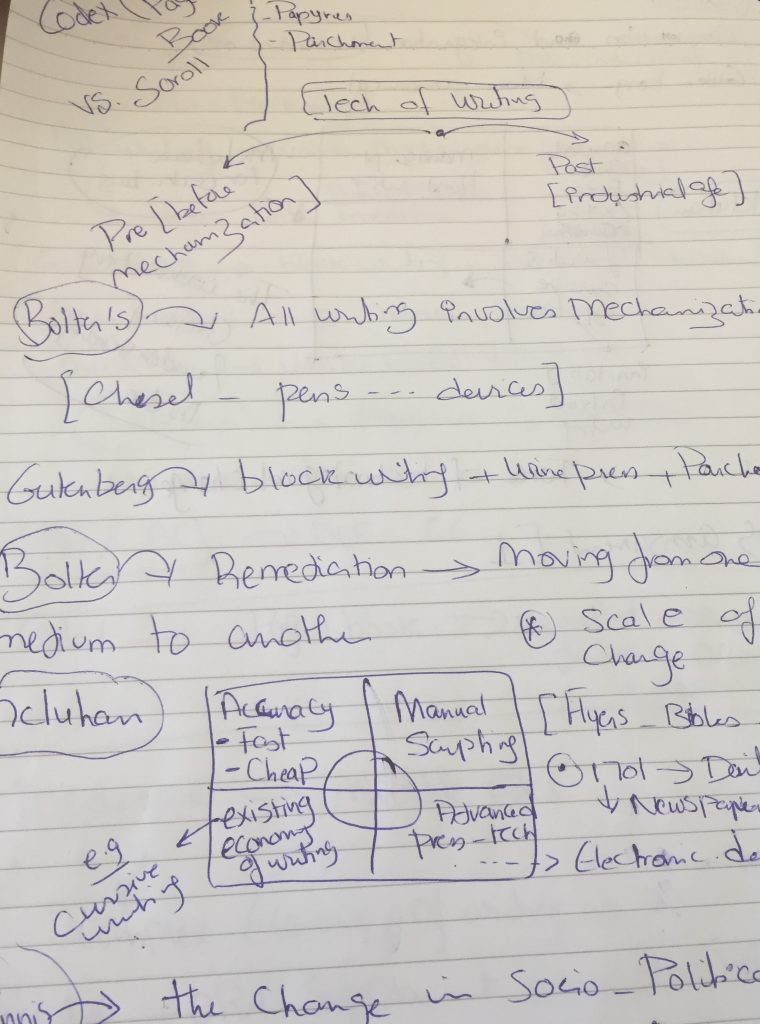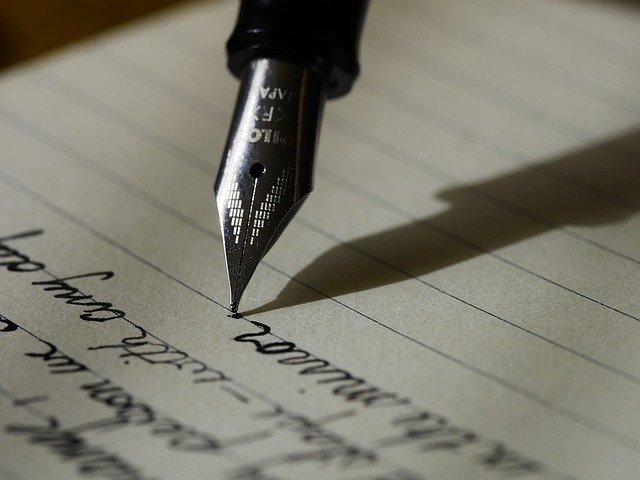Task 4 | Manual Scripts
For this task, I wrote my insights and reflection on a virtual professional development session entitled “Developing and Evaluating Relational Skills” that I attended on February 1st, 2021. The session was conducted by Katie Ruch, my colleague in the public relations department. A scanned copy of the final hand-written script can be found below.
Reflection on the Manual Scripting Task
In our first assignment, I mentioned that I handwrite, and I still brainstorm my ideas manually. I always have several notebooks, pens, and pencils, no matter where I am . I use them to take notes in meetings or from readings or videos; I actually took notes while listening to “The Printed Book: Opening the Floodgates of Knowledge” and reading through the module pages. However, these notes are scribbles, incomplete sentences, and nothing comprehensive; it is only for personal use to quickly recall the most critical aspects of the material (see the image below). I usually refer to them when I need to achieve a conceptual understanding of the material and complete the course activities or assignments.

Snapshot of my handwritten scribbles & notes
The writing task wasn’t challenging. I grew up when handwriting was dominantly used in schools. I used to draft a first copy of an assignment or activity using a pencil or pen, then re-write a good final copy to hand over for grading; typically, the final document was written using a pen (i.e., mandatory). My digital writing journey didn’t start until I was introduced to Microsoft Office for Windows 95 in college; the electronic option has been much faster and more comfortable than manual scripting. Ever since then, I have turned to the QWERTY keyboards to compose all formal documents and messages. The only exception was taking the IELTS writing exam (the MET admission requirement for applicants with international credentials) as the exam candidates were required to compose a lengthy essay by hand; this was around three years ago.
I followed the same technique of my days at school to complete the writing task. I wrote my first draft (see the sample page below) on the same day of the workshop while my thoughts were still new and fresh. I used a notebook and a pen to document my thoughts. However, since the mistakes couldn’t be erased while using a pen, for editing this draft copy, I needed to cross out or write over the words, and as I recalled more details, I had to add words in the margins and between lines. While such representation is a visual record of the written text and all its development stages, the sample page is disorganized and hard to read (my handwriting isn’t perfect in the first place). On the next day, I wrote my final copy, which I shared earlier. I used a pencil instead of pen, perhaps because I always thought that the pencil represents the fact that humans are fallible; editing was much more facile as removing mistakes is now possible. As the second copy was meant for submission, I needed to keep track of the number of words. For typing, counting words isn’t much of a burden, while, there aren’t any automatic calculations for handwriting. So to do this, I had to count the words per line, then count the lines per page, and finally multiply the pages by lines to estimate the number of words. I believe I fulfilled all task requirements (close to 500 words).

Sample page of my first draft using a pen
There are several differences between hand writing and typing. Firstly, electronic technology is the extension of print press technology, thus, the product is a standardized design/outcome, aesthetically pleasing, and higher in quality (i.e., perfectly balanced spacing between letters, words and lines, standardized font type and size, equal margins on both sides of the page, etc.). In contrast, it is hard to find such uniformity in handwriting. Although standardized output is favored in composing formal documents, some might think it conceals one’s identity (e.g., neatness, artistic skills, etc.). Moreover, typing may seem restrictive to creativity and freedom in a sense, for instance, individuals cannot produce typography that is not featured by the software (Chemin, 2014, December 16). Secondly, typing has profoundly facilitated the editing process. Throughout text editors, we can easily remove words, rearrange sentences and paragraphs, copy text and citations from references and other documents, keep track of the word count, detect spelling and grammatical mistakes, and so forth. On the contrary, manual writing lacks such facilities, which often requires multiple hand-written drafts and being more conscious of the spelling and punctuation. I have been overly dependent on “Grammarly” for a long time, it would detect these mistakes on my behalf and suggest corrections. Thirdly, some research work suggests that typing and handwriting promote different cognitive processes (Chemin, 2014, December 16). In the research study, “The Pen Is Mightier Than the Keyboard: Advantages of Longhand Over Laptop Note Taking”, Mueller and Oppenheimer (2014) have reported that writing notes by hand during lectures involves deeper cognitive-processing of the material than typing. The researcher explained as the majority of people cannot write as fast as they type, taking notes by hand requires filtering what truly matters or the most important aspects of what is being said from the unnecessary (i.e., nonverbatim note taking) (Mueller & Oppenheimer, 2014). On the other hand, Anne Trubek, the author of “The History and Uncertain Future of Handwriting” argues that typing promotes “cognitive automaticity” (2016, para. 8), thus, our brains are free to think and focus prominently on the ideas that we are writing about rather than the writing process itself (Trubek, 2016). Lastly, while this is not the focus of this task, the electronic option facilitates sharing and collaboration through technological mediums such as Google Docs. I am uncertain about how people would cooperate in handwritten tasks within this current status.
With that being said, the ease of entering and changing text on a screen, the nearly instant speed of its transmission—all in contrast to the difficulty and slowness of such applications when conducted on paper makes me prefer typing on electronic devices for formal tasks and mass productions rather than handwriting. However, I will continue to handwrite for taking notes, jotting my ideas, and brainstorming before utilizing electronic technology.
Other Thoughts
While searching for the difference between handwriting and typing in terms of how each impacts cognition, I found several articles discussing the ongoing tension between typing and handwriting in the educational sphere. Such arguments are by no means new; the tools and media used for writing have changed a number of times, there have always been questions and concerns about the future of handwriting. Based on the first few weeks in Etec540, I now think that paper, pens and pencils that many consider natural writing spaces; they weren’t one day. They replaced other tools such as scrolls, parchments, and more. Our attachment to them might be thought of as a result of perceptual habits or emotions. While I don’t believe that handwriting will disappear from educational systems, I admit it has been “refashioned” just as many other things have due to the political, economic, and social changes of the digital era (Boltes, 2001).
References
- Bolter, J. D. (2001). Writing space: Computers, hypertext, and the remediation of print (2nd ed.). Mahwah, N.J: Lawrence Erlbaum Associates. doi:10.4324/9781410600110
- Chemin, A. (2014, December 16). Handwriting vs typing: is the pen still mightier than the keyboard?. The Guardian. Retrieved from Handwriting vs typing: is the pen still mightier than the keyboard? | Neuroscience | The Guardian
- Mueller, P. A., & Oppenheimer, D. M. (2014). The pen is mightier than the keyboard: Advantages of longhand over laptop note taking. Psychological Science, 25(6), 1159-1168. doi:10.1177/0956797614524581
- Trubek, A. (2016). Handwriting Just Doesn’t Matter. The New York Times. Retrieved from Opinion | Handwriting Just Doesn’t Matter – The New York Times (nytimes.com)

